|
|
| |
SPAIN
VALENCIA
Valencia is the third largest city in Spain. It is integrated into an industrial area on the Costa del Azahar. Its main festival, the Falles, is known worldwide, while the traditional dish, paella, originated around Valencia. It is on the Mediterranean Sea approximately four hours to the south of Barcelona and three hours to the east of Madrid. Valencia is famous for its Fallas Festival in March, for being the birthplace of paella, for hosting the "2007 & 2010 America's Cup", and for the massive architectural project by Santiago Calatrava called The City of Arts and Sciences.
 City of Arts and Science at night
Ciutat de les Arts i les Ciències
The City of Arts and Sciences is an entertainment-based cultural and architectural complex in the city of Valencia, Spain. It is considered by many to be the most important modern tourist destination in the city of Valencia. The City of the Arts and the Sciences is situated at the end of the old riverbed Turia. The complex is made up of many buildings including El Museu de les Ciències Príncipe Felipe, an interactive museum of science but resembling the skeleton of a whale. The building is over 40,000 square meters in area and resembles the skeleton of a whale. Everything in the museum is graphically displayed: recent exhibitions have included subjects as diverse as spy science, climate change, the human body and biometrics. The City of Arts and Sciences is open 365 days of the year. For more inforamtion and enquiries please contact Ciudad de las Artes y las Ciencias,
Prolongación Paseo de la Alameda, 48
46023 Valencia, Tel: 902 100 031
Valencia Cathedral
The Metropolitan Cathedral-Basilica of the Assumption of Our Lady of Valencia, alternatively known as Saint Mary's Cathedral or Valencia Cathedral, is the seat of the Archbishops of Valencia. The predominant style of the cathedral is gothic although it also contains Romanesque, French Gothic, Renaissance art, Baroque and Neo-Classical elements. Valencia Cathedral also contains examples of some of the earliest and best Quattrocento paintings of the Iberian Peninsula, by artists from Rome engaged by Valencian Pope Alexander VI.
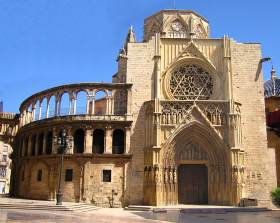
Valencia Cathedral from the west (Our Lady Square)Museu Valencià d'Etnologia
The Valencian Museum of Ethnology aims to promote research and circulate knowledge regarding the fields of Ethnology and Anthropology, making a dynamic informative space available to the public. temporary exhibitions and educational workshops are also organised. The Museum carries out a research activity that develops different projects and awards the Bernat Capó prize for disseminating popular culture. The Museum has a library and document centre specialised in ethnology and anthropology. The facilities of the Museum include the former psychiatric hospital of Bétera, where a collection of around 10,000 objects is stored and catalogued. For more information and visiting hours please contact Museu Valencià d'Etnologia, C/ Corona 36, 46003 Valencia,
Spain, Tel: 96 388 35 65
E-mail: muvaet@dival.es
 Central MarketMercado Central
Mercado Central (Central Market) is a public market located in Valencia, Spain. It is generally considered one of the oldest and largest European markets still running. Most vendors sell food items, however, souvenir shops and restaurants are located inside the market as well. It is a popular location for tourists and locals alike.
Llotja de la Seda
The Llotja de la Seda is a late Valencian Gothic style civil building in Valencia, Spain, built between 1482 and 1548, and one of the principal tourist attractions in the city. The UNESCO considered it as a World Heritage Site in 1996 since "the site is of outstanding universal value as it is a wholly exceptional example of a secular building in late Gothic style, which dramatically illustrates the power and wealth of one of the great Mediterranean mercantile cities.". During subsequent centuries, La Lonja functioned as a silk exchange. The honesty of its traders is honored by the inscription that runs around the main contract hall. The architect in charge of the new Lonja was Pere Compte (1447–1506), who built the main body of the building - the Trading Hall or Sala de Contractació (in Valencian) - in only fifteen years (1483–1498).
 Llotja de la Seda
The largest square is the Plaça de l'Ajuntament, which contains the town hall, a cinema which shows classic movies, and many restaurants and bars. This is where the noisy fireworks of the mascletà can be heard every afternoon during the Les Falles. Whilst the The Plaça de la Verge contains the Basilica of the Virgin and the Turia fountain, and is a popular spot for locals and tourists. Around the corner is the Plaça de la Reina, with the Cathedral, orange trees, and many bars and restaurants.
The Barri del Carme
The Barri del Carme is the historical city centre of Valencia. It is the perfect place for a stroll where you can witness the transition from a forgotten area to an up-and-coming diverse neighborhood. Barri del Carme has many outdoor cafes and trendy shops.
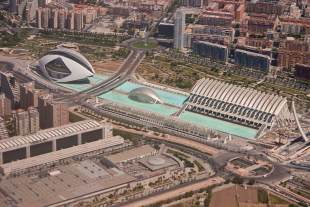 View of the Ciutat de les Arts i les Ciències from above
Photo: Mike Lowe
There are several city beaches, and three major beaches outside of Valencia. Playa de Malvarrosa and Playa e Levante o de la arenas are the most popular city beaches, just north of the port. To get there, take the metro or tram to Eugenia Vines or Arenas station, or take the metro to Maritim Serreria and continue with the tram to Neptu (all on one ticket). El Saler is the nicest and best developed beach near Valencia. Devesa is undeveloped and has nice surroundings. At Devesa and Playa Pinedo there are nudist sections. These beaches are located south of the port. To reach them, take the Yellow Bus (operated by "Herca") from Calle Alicante near the train station, in direction "Perello". The trip takes about 30 minutes; the train runs hourly 7am - 9pm.
|
|
|
Festivals & Events
Seville Fair
The Feria de abril de Sevilla, literally Seville April Fair, is held
in the Andalusian capital of Seville, Spain. The fair generally begins
two weeks after the Semana Santa, or Easter Holy Week. The fair
officially begins at midnight on Monday, and runs six days, ending on
the following Sunday. Each day the fiesta begins with the parade of
carriages and riders, at midday, carrying Seville's leading citizens
which make their way to the bullring, La Real Maestranza, where the
bullfighters and breeders meet.
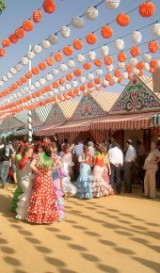 Casetas at Seville Fair
Photo: EdTarwinski
San Fermín
The festival of San Fermín is renowned for it's celebratory
tradition and is held in Pamplona anually on the 6th July. It is known
locally as Sanfermines and is held in honour of Saint Fermin. This
festival is important in terms of Spanish folklore and tradition. The
week long fiesta is most famous for it's encierro (running of the
bulls). It is belived that a million people flock to see this event
every year. The opening of the fiesta is marked by setting off the
pyrotechnic chupinazo. The rocket is launched at 12:00 noon on the 6th
of July from a city hall balcony with thousands of people celebrating
the act in the city hall square and other locations in Pamplona.
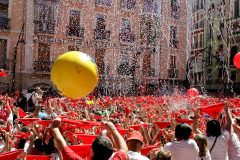 San Fermín Festival seen from
the Town Hall in Pamplona
Photo: Viajar24h
Fiestas del Pilar
Fiestas del Pilar is a large festival that takes place in Zaragoza,
Spain. This festival is religiously rooted in Spain and based on the
belief that Virgin Mary appeared to Saint James standing on a pillar.
The celebration lasts for seven days during which the city is bustling
with energy as over two million people visit the city for this fiesta.
Every day at 8 o'clock in the morning there is an event called
vaquillas, that is amateur bullfighting in the towns bullfighting ring,
or Plaza de toros. Everyone who is brave enough, can participate in this
event, in which many people get injured every year. The most important
celebration takes place on the 12th October, "The offering of flowers"
to the Virgin, who is removed from the Basilica and exhibited in a
platform placed on the square where the temple lies. The Offering of
Flowers is one of the more famous festive symbols of Spain.
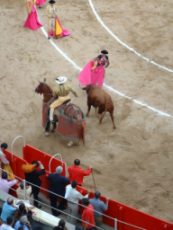 San Fermín Festival seen from
Bull running in Barcelona
Photo: BPG
Carnival
Carnival is a festive season which occurs immediately before Lent;
the main events are usually during February. Carnival typically involves
a public celebration or parade combining some elements of a circus,
mask and public street party. The Santa Cruz de Tenerifeand Las Palmas
de Gran Canaria is together with the Carnival of Cadiz, the most
important festival for Spanish tourism and Spain's largest carnival. In
Catalonia people dress up and organise parties for a week but
particularly on the weekend. Despite it being winter, parties are open
air, beginning with a cercavila to call everybody to come. Rues of
people dance along the streets. On Thursday Dijous Gras is celebrated,
also called 'the omelette day' and omelettes are eaten. Parties end by
burning Mr. Carnestoltes and with enterrament de la sardina (sardine's
funeral). Carnaval de Solsona takes place in Solsona, Lleida in central
Catalonia. It is one of the longest carnivals in Catalonia; free events
in the streets, and concerts every night, run for more than a week.
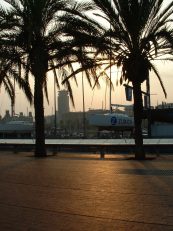 Barcelona harbour
Photo: BPG
Festival Internacional de Benicàssim
The Festival Internacional de Benicàssim is an annual music festival
sponsored by a well known beer label which takes place in the village of
Benicàssim, province of Castelló, Valencian Community in Spain. It
focuses mainly on pop, rock and electronica artists, as well as having
other elements besides music like short films, theatre, fashion and art.
Since the first festival in 1995, some of the most notable artists who
have played the festival include Paul Weller, Depeche Mode, Beck,
Radiohead, Kraftwerk, The Stone Roses, Brian Wilson, Blur, Lou Reed,
Oasis, The Chemical Brothers, Franz Ferdinand, The Killers, Morrissey,
Sigur Rós, Ride and The Strokes. As of 28 January, the line up for the
2011 Festival is as follows: Arcade Fire, Arctic Monkeys, Mumford &
Sons, Portishead, The Strokes, Beirut, Catpeople, Elbow, Friendly Fires,
Julieta Venegas, Lori Meyers, Primal Scream (present Screamadelica),
The Streets, Tinie Tempah, The Coronas, Grupo Salvaje, The Marzipan Man
Smile, Veronica Falls, Paolo Nutini, Pendulum, Mahmiri Acar. 'FIB' is
held in the seaside resort of Benicassim (Castellón province) on Costa
del Azahar, Valencia, Spain, 92.2 km away from Valencia Airport.
Festival goers who have purchased multi-day passes can camp for up to 9
days starting Monday before the festival starts and ending Tuesday after
the festival has ended. For more information please contact info@fiberfib.com
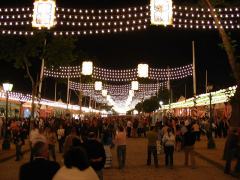
Festimad
Festimad is an alternative rock festival and cultural event held yearly
in Madrid, Spain since 1994, usually in the last week of May. Festimad
includes several parallel cultural festivals such as Performa, Graffiti,
Universimad o Cinemad, although its central event continues to be the
music festival, standing alongside the Festival Internacional de
Benicàssim as Spain's main rock concert. For more information please
contact festimad@festimad.es
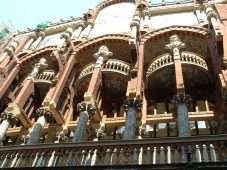 Photo: BPG
Bilbao Live Festival
The Bilbao Live Festival is a rock and pop music festival that takes
place in the summer in Bilbao, Spain since 2006. It is supported by BBK
the savings bank. Some 51,000 people attended the first edition of
Bilbao Live Festival in 2006, an event that reunited during three days
more than 40 national and international bands of rock and carps of
electronic music. Bilbao had thus burst in with force into the circuit
of great musical festivals of the summer time. The 2011 lineup includes
Coldplay, Blondie, Beady Eye, Crystal Castles, Russian Red, Ken Zazpi,
Amy Winehouse, Kasabian, Kaiser Chiefs, The Black Crowes, The Chemical
Brothers, Jack Johnson, 30 Seconds to Mars, M-Clan. For more information
please contact festivals@nme.com
|